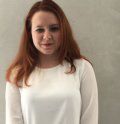 In this thesis a novel platform for 3D nanofabrications is proposed and demonstrated.
In this thesis a novel platform for 3D nanofabrications is proposed and demonstrated.
‘Our innovative approach is to pattern oblique surfaces in one step,’ Diana Grishina says. ‘Industry is already making 3D chips, layer by layer. I believe, at some point, our approach using single-step etch masks, will be very useful in industry, as multiple stacking demands numerous very precise alignment steps.’
The first masks Diana showed were designed for fabrication of 3D photonic crystals. The alignment between the planes appeared about 3 to 5 nm, according to the resolution of scanning electron microscopy used. ‘After showing this proof of principle, we expanded our ambitions towards deep UV lithography,’ Diana says.
Using deep reactive ion etching, very small and deep pores in silicon, with aspect ratios as high as 42, were reached. Diana: ‘We then considered and studied etching of two perpendicular sets of pores, to form 3D structures. We fabricated 3D photonic band gap crystals with and without embedded defects. By doing so, we showed our creative research and experimental spirit. Beforehand not many colleagues believed we would be able to reach this kind of high quality results.’
Diana stresses the importance of the facilities available at the Nanolab. ‘At Mesa+ we most likely have the best university cleanroom in the Netherlands,’ she says. ‘Not only the facilities are great. Especially the maintenance level is amazingly high in standard. Above that, every apparatus has its own technician experts to help you out and, in collaboration, design clever experiments.’
Record deep pores
For example the focused ion beam lithography in combination with deep reactive ion etching was used on sloped samples. ‘We realized ultra-aspect ratios, using novel deep reactive ion etching equipment,’ Diana says. ‘We reached a world record, etching 22 µm deep pores. It is a good thing to realize many features of this equipment are not used or optimized as yet. So, more output performances still lie ahead of us.’
ASML
A part of Diana’s PhD research work was in collaboration with ASML. ‘Academic facilities cannot manage production rates in industry,’ Diana says. ‘However, we convincingly proved added value in functionality, and provided exciting outskirts for future fabrication processes.’
Apart from learning many fabrication and experimental skills, the PhD work brought Diana to the ESRF Synchrotron facilities in Grenoble.
‘We were the first to bring in samples for X-Ray tomography measurements on photonic nanostructures,’ Diana says. ‘High resolution measurements could be performed up to resolutions on 10-20 nm scales. The pores in different directions could be characterized in 3D images without destructing the sculptured crystals.’
Photonic band gaps
‘Our created complex structures of silicon and entrapped air, are called meta-materials. The sculptured materials possess surprising features, such as photonic band gaps in which light cannot exist. These “prisons of light” serve as an important experimental tool, as we are now able to etch in embedded defects, and perform special reflective measurements from there.’
Future
Diana concludes that the results of her PhD work provide a platform for further development of 3D silicon nanophotonics.
‘My future job is likely to be in industry,’ she says. ‘I like to see how my research is used one day. Also I would like to work in a research field where I can find something really new., like I did in my PhD project. We fabricated 3D structures that were never shown before, or were held possible. I hope my future job in nanofabrication and optics, will have these characteristics.’
Mesa+ Days
During her PhD Diana happily joint the yearly Mesa+ Days. ‘The talks were always interesting, and close to topic,’ she says. ‘In discussions during that Days, interesting collaboration ideas emerged, for example with the Computational Science Group. Also inspiring were the colloquia meetings within our Applied Nanophotonics network.’
